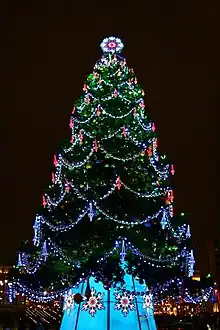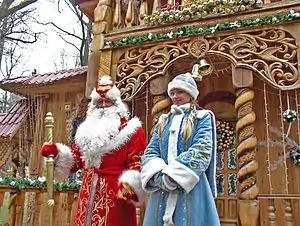

Novy God (Russian: Новый Год) is the Russian phrase for "New Year", and also designates the Russian New Year's Eve and New Year's Day celebration.
Similar customs are observed in all post-Soviet states, and though the observance of the holiday is criticised by conservative Muslim groups in Central Asia,[1] and nationalist groups in Ukraine,[2] it remains popular across the region.
Traditions
Since the era of the Soviet Union, Novy God has usually been considered a gift-giving holiday with similarities to Christmas (albeit in a secular form), with New Year trees (yolka) decorated and displayed in homes and public spaces,[3][4][5] and Ded Moroz (Russian: Дед Мороз, lit. 'Grandfather Frost') depicted as delivering presents to children on New Year's Eve (similar to the Western figure of Santa Claus),[6][4][5] with assistance from his granddaughter Snegurochka (Russian: Снегурочка, lit. 'the Snow Maiden').[7]
The President's New Year's address is traditionally televised shortly before midnight in each time zone, reflecting on the previous year and the state of the country.[8][9] At Moscow's Red Square, revellers gather under the Kremlin Clock—whose chimes at midnight are traditionally followed by the playing of the Russian national anthem, and a fireworks display.[10]
Russia-1 televises the annual special Little Blue Light (Russian: Голубой огонёк), which features music and variety acts,[11][12][13] while the Soviet film The Irony of Fate is also traditionally aired on New Year's Eve.[14][12]
Russians generally take the week between New Year and Christmas (celebrated on 7 January, corresponding to Christmas Day according to the Julian Calendar) off (Новогодние каникулы "New Year's holidays"). Unlike Christmas, the Russian New Year uses the Gregorian calendar.
History
From AD 1492, the new year was originally celebrated on 1 September as per the Byzantine calendar.[15] In 1699, Peter the Great issued a proclamation adopting the Christian era beginning in 1700 and also changing the celebration of the new year to 1 January.[16] He called for streets to be decorated with the branches of fir, juniper, and pine trees for the holiday. The tradition later evolved into the practice of decorated New Year trees, although their use in homes was hindered by the Slavic superstition of fir trees being associated with funeral rites.[4][17]
After the October Revolution, Russia adopted the Soviet calendar, which was derived from the Gregorian calendar, in 1918.[4][17] In 1929, the Communist Party of the Soviet Union abolished all religious holidays, including Christmas, as part of a wider campaign against religion. Soviet officials argued that Christmas was a pagan ritual of sun worship and that the Christmas tree was a bourgeois symbol originating from Germany — one of Russia's World War I enemies.[4]
In December 1935, via a letter published by the party's official newspaper Pravda, politician Pavel Postyshev proposed that the New Year be celebrated as a secular holiday benefiting Soviet youth. The celebration would adopt Christmas traditions in a secular form, including New Year trees (stated to symbolise happiness and prosperity among youth) replacing Christmas trees, and the figure of Ded Moroz.[18][4]
On television, the Soviet variety show Little Blue Light (Goluboy ogonyok) traditionally ran an episode on New Year's Eve from 1962 to 1985.[11][12]
Even after the dissolution of the Soviet Union and the reinstatement of religious holidays, Novy God has remained a popular celebration in modern Russia,[19][20][21] and among Soviet expats living in other countries.[22] The Little Blue Light New Year's Eve special was revived in 1997,[11][12] and Ded Moroz has continued to be emphasised in an effort to prevent the encroachment of Santa Claus; a residence in the town of Veliky Ustyug is promoted as his "home", children are encouraged to write letters to him, and GLONASS has promoted a Ded Moroz "tracker" on New Year's Eve similar to the NORAD Tracks Santa campaign.[23][4]
In other countries
Israel
In Israel, Novy God (נובי גוד) is celebrated by many first– and second–generation Russian Jewish immigrants from the Soviet Union, with celebrations being particularly prominent in areas with a large ex-Soviet population (such as Ashdod, Ashqelon, Beersheba, Netanya, and Haifa).[24][25] Some customs have been adapted for Israeli environs, like the use of palm trees for the New Year tree and starting celebrations using the Moscow time zone.[26]
In Israel, New Year's Eve celebrations that are associated with the Gregorian calendar or Christianity are referred to as Silvester, to distinguish it from the Jewish New Year of Rosh Hashanah (which takes place 2–3 months earlier). As Pope Sylvester I is considered to have been an anti-semite, New Year's Eve celebrations have not been as popular among the Israeli Jew population.[27][28][29] Those who celebrate Novy God are sometimes seen as out of line with the national Jewish identity despite the event's lack of religious affiliation, with some having confused it for Christmas or Silvester; amongst ultra-orthodox groups, anti-Novy God flyers and chain letters[30] are common, and in 2004 a bill that would ban the presentation of Christmas iconography in schools was presented to the Knesset.[31] In the late-2010s, campaigns were undertaken to promote public awareness of the holiday among Israelis and the 1.5 generation, while Prime Minister Benjamin Netanyahu also began to acknowledge the holiday in his greetings.[32][33][34]
It is common to allow soldiers of Russian-speaking heritage serving in noncombat facilities to go on leave on the night of the 31st to allow them to celebrate the holiday; however, this is not enforced by official order.[35]
See also
References
- ↑ "Central Asians Stand By 'Un-Islamic' New Year's Traditions". RadioFreeEurope/RadioLiberty. Archived from the original on 31 December 2016. Retrieved 12 June 2017.
- ↑ "No Ukrainian should have a Soviet-style New Year's tree". Euromaidan Press. 26 December 2016. Archived from the original on 2 May 2017. Retrieved 12 June 2017.
- ↑ "Father Frost and the Snow Maiden deliver Russia's winter warmer, by Helen Womack, 31 December 1996". The Independent. London. 31 December 1996. Archived from the original on 18 June 2022. Retrieved 12 December 2010.
- 1 2 3 4 5 6 7 Weber, Hannah (25 December 2020). "Yolka: the story of Russia's 'New Year tree', from pagan origins to Soviet celebrations". The Calvert Journal. Archived from the original on 13 January 2018. Retrieved 12 June 2021.
- 1 2 Echo of Islam. MIG. 1993.
In the former Soviet Union, fir trees were usually put up to mark New Year's day, following a tradition established by the officially atheist state.
- ↑ "Father Frost and the Snow Maiden deliver Russia's winter warmer, by Helen Womack, 31 December 1996". The Independent. London. 31 December 1996. Archived from the original on 18 June 2022. Retrieved 12 December 2010.
- ↑ Душечкина Е. В. (2003). "Дед Мороз и Снегурочка". Отечественные записки. No. 1. Archived from the original on 27 June 2019. Retrieved 5 September 2022.
- ↑ Zubtsov, Vitaly (29 December 2016). "Survival guide: How to survive New Year, Russian-style". Russia Beyond. Archived from the original on 1 January 2019. Retrieved 31 December 2018.
- ↑ "The 10 Best Places to Spend New Year's Eve in Moscow". The Moscow Times. 29 December 2014. Archived from the original on 1 January 2019. Retrieved 31 December 2018.
- ↑ "Russia Unveils New National Anthem Joining the Old Soviet Tune to the Older, Unsoviet God". The New York Times. Associated Press. 31 December 2000. ISSN 0362-4331. Archived from the original on 28 December 2018. Retrieved 31 December 2018.
- 1 2 3 "Inventorying the Past: Russia Refreshes Its Historical Memory". Wilson Center. Archived from the original on 3 September 2022. Retrieved 3 September 2022.
- 1 2 3 4 "Holiday TV Traditions Around The World". The Hollywood Reporter. 22 December 2017. Archived from the original on 3 September 2022. Retrieved 3 September 2022.
- ↑ "Красно-бело-голубой огонек". www.kommersant.ru (in Russian). 26 December 2005. Archived from the original on 26 December 2017. Retrieved 5 September 2022.
- ↑ Horton, Andrew; Brashinsky, Michael (1992). The Zero Hour: Glasnost and Soviet Cinema in Transition. Princeton University Press. ISBN 9780691019208. p. 171.
- ↑ Черепнин, Л. В. "Русская хронология" (in Russian). p. 26. Archived from the original on 24 December 2013. Retrieved 31 December 2022.
- ↑ "Russia in the Age of Peter the Great". archive.nytimes.com. Archived from the original on 5 September 2022. Retrieved 5 September 2022.
- 1 2 Tamkin, Emily (30 December 2016). "How Soviets Came to Celebrate New Year's Like Christmas (and Why Russians Still Do)". Foreign Policy. Archived from the original on 19 April 2021. Retrieved 5 September 2022.
- ↑ Karen Petrone, Life Has Become More Joyous, Comrades: Celebrations in the Time of Stalin, Indiana University Press, 200, ISBN 0-253-33768-2, Google Print, p.85 Archived 4 April 2023 at the Wayback Machine
- ↑ Dice, Elizabeth A. (2009). Christmas and Hanukkah. Infobase Publishing. p. 44. ISBN 9781438119717.
The Christmas tree, or Yolka, is another tradition that was banned during the Soviet era. To keep the custom alive, people decorated New Year's trees instead.
- ↑ "Russia's answer to Father Christmas". CNN.com. 26 December 2000. Archived from the original on 1 January 2019. Retrieved 31 December 2018.
- ↑ "Father Frost and the Snow Maiden deliver Russia's winter warmer, by Helen Womack, 31 December 1996". The Independent. London. 31 December 1996. Archived from the original on 18 June 2022. Retrieved 12 December 2010.
- ↑ Neiman, Rachel (30 December 2019). "Celebrating Silvester, AKA the secular New Year, in Israel". ISRAEL21c. Archived from the original on 11 June 2022. Retrieved 5 September 2022.
- ↑ "What on earth is happening with "Russia's GPS"?, Dec 1, 2009 by Julia Ioffe". Fortune. Archived from the original on 13 September 2010. Retrieved 20 November 2010.
- ↑ "A Happy Novy God (Without God)". Haaretz. Archived from the original on 2 December 2022. Retrieved 2 December 2022.
- ↑ "דרישה בנתניה: העירייה צריכה לממן את חגיגות הסילבסטר". NRG (in Hebrew). Archived from the original on 12 April 2023. Retrieved 2 December 2022.
- ↑ "Igor Ebadusin - celebrations of Novy God within ex-USSR immigrants". Archived from the original on 24 December 2016. Retrieved 1 January 2012.
- ↑ "Celebrating an anti-Semitic pope on Sylvester". The Jerusalem Post - Christian World. Archived from the original on 31 December 2014. Retrieved 10 September 2022.
- ↑ Kershner, Isabel (30 December 2018). "New Year's Fete From Russia Irks Some in Israel: 'It's Not a Jewish Holiday'". The New York Times. ISSN 0362-4331. Archived from the original on 10 September 2022. Retrieved 10 September 2022.
- ↑ קריסטל, מירב (2 January 2010). ""הרוסים לא חוגגים את הסילבסטר"". Ynet (in Hebrew). Archived from the original on 2 December 2022. Retrieved 2 December 2022.
- ↑ "Anti-Novy God chain letter (Hebrew)". Archived from the original on 5 January 2012. Retrieved 1 January 2012.
- ↑ צור, רענן בן (12 January 2004). "הכנסת קבעה: בלי עצי אשוח ובלי סנטה קלאוס". Ynet (in Hebrew). Archived from the original on 2 December 2022. Retrieved 2 December 2022.
- ↑ Barak, Naama (27 December 2021). "Making a home for Novy God in the Israeli calendar". ISRAEL21c. Archived from the original on 10 September 2022. Retrieved 10 September 2022.
- ↑ "What is Novy God? What you need to know about the Russian new year". The Jerusalem Post | JPost.com. Archived from the original on 10 September 2022. Retrieved 10 September 2022.
- ↑ Kershner, Isabel (30 December 2018). "New Year's Fete From Russia Irks Some in Israel: 'It's Not a Jewish Holiday'". The New York Times. ISSN 0362-4331. Archived from the original on 10 September 2022. Retrieved 10 September 2022.
- ↑ "Archived copy". www.idf.il. Archived from the original on 29 May 2016. Retrieved 2 December 2022.
{{cite web}}: CS1 maint: archived copy as title (link)
External links
 Media related to New Year in Azerbaijan at Wikimedia Commons
Media related to New Year in Azerbaijan at Wikimedia Commons Media related to New Year in Russia at Wikimedia Commons
Media related to New Year in Russia at Wikimedia Commons Media related to New Year in Ukraine at Wikimedia Commons
Media related to New Year in Ukraine at Wikimedia Commons